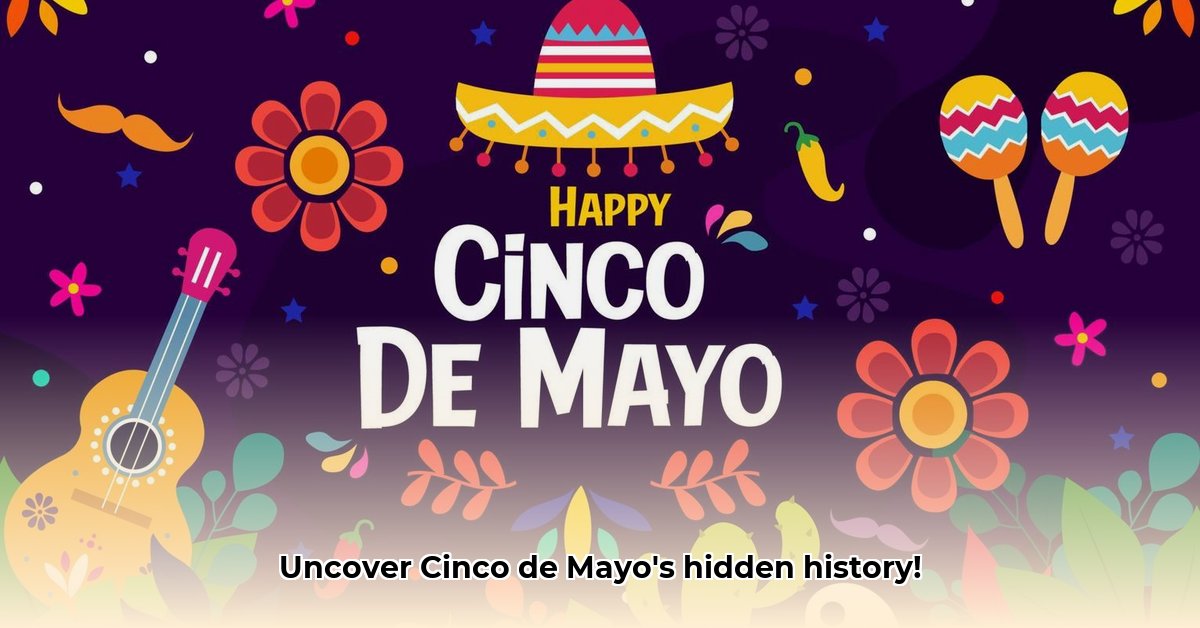Forget the stereotypes! Cinco de Mayo is more than just margaritas and sombreros. It’s a day steeped in history, culture, and profound meaning, particularly for Mexican-Americans. This guide transcends typical party planning; we’ll explore the story behind the celebrations, from an unexpected triumph in a distant battle to its rise as a major event in the US. We’ll dispel common misconceptions, compare Cinco de Mayo celebrations in Mexico and the States, and provide tips for a fun and respectful celebration this year. Prepare to expand your knowledge and elevate your experience – let’s uncover the true story of Cinco de Mayo!
Happy Cinco de Mayo: Unveiling the Celebration’s Roots
Embark on a journey into the vibrant world of Cinco de Mayo! It’s more than just a party; it’s a narrative woven with history, culture, and festive traditions. But what are the origins of this spirited celebration, and what significance does it truly hold?
The Battle of Puebla: A Mexican David and Goliath Story of Resilience
Rewind to May 5, 1862. Picture this: Mexico, confronted by the formidable French army, achieves an improbable victory at the Battle of Puebla. Although not a decisive military triumph, this victory served as a crucial morale booster for Mexico. Envision a small David defeating a giant Goliath – a potent symbol of hope amid adversity. This underdog victory is the cornerstone of Cinco de Mayo, with its themes of resilience and unwavering spirit resonating in contemporary celebrations.
From Humble Remembrance to National Celebration: The US Transformation of Cinco de Mayo
While Mexico commemorates the battle’s anniversary, it’s within the United States that Cinco de Mayo has truly flourished. This evolution is remarkable! The Chicano Movement of the 1960s and 70s played a pivotal role. This dynamic cultural movement adopted Cinco de Mayo as an emblem of Mexican-American pride and a powerful affirmation of their heritage. It became a vehicle for expressing their identity and strength. Beginning in the 1980s, businesses amplified Cinco de Mayo’s reach, transforming it into the expansive celebration observed today. It’s remarkable how a moment of remembrance evolved into a widespread national fiesta!
Exploring the Cultural Core: Diverse Interpretations, United Celebration of Heritage
It’s essential to understand that Cinco de Mayo enjoys greater prominence in the US than in Mexico. In Mexico, observances tend to be localized and regional. This divergence stems from the unique history and identity of Mexican-Americans, for whom Cinco de Mayo embodies community and shared heritage. It’s a poignant reminder of their ancestors’ struggles and a testament to their enduring spirit. For many, Cinco de Mayo represents more than just a celebration; it’s a tribute to family, pride, and cultural identity.
Setting the Record Straight: Distinguishing Cinco de Mayo from Mexican Independence Day
Let’s dispel a common misconception. Cinco de Mayo is frequently confused with Mexican Independence Day (September 16th). These are distinct events! Cinco de Mayo commemorates the Battle of Puebla, whereas Mexican Independence Day celebrates Mexico’s independence from Spain. Upholding this distinction demonstrates respect for the profound history and true meaning of Cinco de Mayo.
Fostering Meaningful Celebrations: Responsible Festivities and Cultural Sensitivity
A truly happy Cinco de Mayo entails celebrating responsibly and respectfully. Let’s honor the cultural significance, historical context, and communal joy. Patronize local Mexican-American businesses – they are the heart of the celebration. Deepen your understanding of the history and significance of the day. Above all, let’s remember that responsible enjoyment – of food, drink, and festivities – is the key to creating a memorable holiday for all. It’s about unity and sharing great moments.
Your Guide to an Enriching Cinco de Mayo Experience:
Here’s how to make this Cinco de Mayo especially meaningful:
- Delve into History: Dedicate time to learning about the Battle of Puebla. Understanding its context enriches the celebration.
- Support Local Enterprises: Seek out and support businesses owned by Mexican-Americans to help strengthen their community.
- Immerse Yourself in Heritage: Attend local events, savor traditional Mexican cuisine, and learn a few Spanish phrases for a deeper cultural connection.
- Share the Narrative: Inform friends and family about the true significance of Cinco de Mayo to keep its spirit alive.
- Celebrate Consciously: Enjoy festivities safely and respectfully by prioritizing fun and good company.
By embracing these simple steps, we can ensure a happy and meaningful Cinco de Mayo that respects history and culture. Let’s celebrate responsibly and embrace the rich history and culture! Happy Cinco de Mayo!
How Cinco de Mayo’s Significance Evolved Differently in Mexico and the US: A Tale of Two Celebrations
Explore the fascinating story of Cinco de Mayo – a holiday with contrasting interpretations across borders. This is a narrative of military victories, cultural identity, and shrewd marketing.
A Modest Victory, a Powerful Symbol of Patriotism Awareness
Cinco de Mayo commemorates the Mexican army’s unexpected triumph over French forces at the Battle of Puebla on May 5, 1862. Picture it as a David versus Goliath moment. While not a decisive turning point in the war, the battle elevated Mexican morale and symbolized resistance against foreign oppression. In Mexico, however, it’s primarily a regional holiday, observed mainly in Puebla.
The American Evolution: From Obscurity to Mega-Celebration of Cultural Identity
How did Cinco de Mayo’s meaning evolve differently in Mexico and the US? The answer resides in the holiday’s intriguing journey within the United States. Initially a relatively obscure commemoration, its popularity surged in the late 20th century. The Chicano movement of the 1960s played a significant role, reclaiming the holiday as a symbol of Mexican-American heritage and resistance to discrimination. Subsequent commercialization, largely by beer companies and other businesses, further amplified its visibility, transforming it into a widespread celebration.
Cultural Tapestry of Contrasts: The Meaning of Resistance
Here’s where it becomes interesting. The U.S. celebration emphasizes Mexican-American identity and cultural pride – often expressed through plentiful food, music, and festivities — in Mexico, the occasion is more subdued. It’s a remembrance, not the grand spectacle seen further north. This contrast underscores the complex ways in which cultural symbols are adopted, adapted, and at times, reframed across borders.
Dispelling Common Misconceptions: Separating Facts from Storytelling
It’s crucial to clarify: Cinco de Mayo is not Mexican Independence Day! That holiday is celebrated on September 16th. This common misconception highlights the need for deepened understanding of the holiday’s true historical significance.
Celebrating Responsibly: Respect, Awareness, and Genuine Appreciation
Respectful engagement with Cinco de Mayo means acknowledging the historical context and cultural importance, not just the party atmosphere. Supporting local Mexican-American businesses, learning about the holiday’s history, and actively engaging with the community are effective ways to celebrate responsibly.
Key Insights:
- Cinco de Mayo commemorates a pivotal battle, but its impact varies across Mexico and the U.S.
- The holiday’s significance in the U.S. was bolstered by the Chicano movement and commercial interests.
- Grasping the historical context is key to celebrating respectfully and meaningfully.
- It’s NOT Mexican Independence Day. Don’t make that mistake!
- Responsible celebration involves valuing the cultural significance and supporting local communities.
Cinco de Mayo Celebrations: A Comparative Study of Regional Traditions in Mexico and the US
Enter the vibrant realm of Cinco de Mayo! But first, a question: Do you understand what Cinco de Mayo actually celebrates? Many in the US primarily associate it with parties and festive gatherings. The full story is more expansive, nuanced, and encompasses two nations.
The Battle of Puebla: A Defining Moment in Mexican History
Cinco de Mayo commemorates the Mexican army’s against-the-odds victory over French forces at the Battle of Puebla on May 5, 1862. This was more than a military triumph; it symbolized Mexican resistance against foreign intervention. The unexpected victory bolstered Mexican morale during a time of upheaval. It’s important to recognize that this victory did not conclude the Franco-Mexican War. It was a landmark battle, a moment of national pride, but the war persisted.
Cinco de Mayo in Mexico: A Regional Celebration Reflection
Within Mexico, Cinco de Mayo mainly remains a regional holiday, predominantly celebrated in Puebla. Envision it as a local town festival, instead of a national holiday. While some nearby areas participate, widespread celebration isn’t common throughout the country. Parades and commemorative events can be found locally. Think of it as a local anniversary honoring a significant local event—much like how some smaller towns might commemorate a historical battle or triumph.
Cinco de Mayo in the United States: A Story of Cultural Resurgence
Now, let’s turn northward. The story of Cinco de Mayo in the US is profoundly different. It has transformed since it was a relatively obscure commemoration , into a major cultural phenomenon, particularly among Mexican-American communities.
- Discover Fermentation Revolution: The Health Benefits of Kimchi: Sustainable Farming Practices - July 30, 2025
- Discover Living Crystals: The Giant Gypsum Formations in Naica’s Cave: A Geological Marvel - July 30, 2025
- Master Molecular Gastronomy: The Science That Turns Your Kitchen into a Lab: Beginner-Friendly Recipes - July 30, 2025
















